Be a Wild Bird Feeder!
Tips for attracting backyard birds
Become a wild bird feeder! Attracting backyard birds is easy when you feed them well.
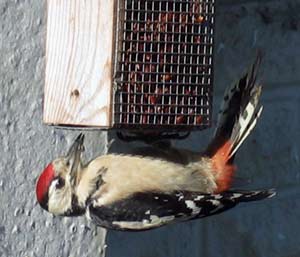
Picture, above: A woodpecker occasionally visits our wild bird feeders
Help your local wildlife - starting with the birds
There are loads of ways that you can help your local wildlife, birds in particular.
Birds are an asset in any garden or backyard. They sing melodiously (OK, they wake you up at four in the morning!) and they look amazing. They are often entertaining to watch and kids love them.
As part of the wider environment, birds contribute to the eco-system, so attracting them to your yard or garden - or even to your windowsill - can be a part of green lifestyle.
Read on for the best and easiest options for a wild bird feeder for your home and for good sources of food for the birds.
Become a wild bird feeder:
What can we do to encourage birds?
The first thing to do is to feed them. Regularly.
Many birds are under threat as their natural habitats shrink, thanks to human activities. Many birds we cannot help much at home because they do not normally visit. Such birds as wheatears for example are rarely seen in gardens, except in the hills or more remote areas.
But plenty of our visiting garden birds are under stress and they will benefit from being fed. A good quality wild bird feeder helps with this aim.
We can also attract backyard birds by giving them more suitable habitat – places to feed, roost and breed.
Become a wild bird feeder:
What’s the best way to feed birds?
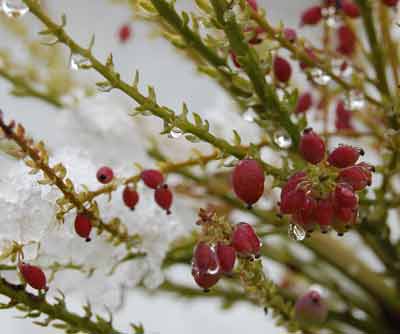
Picture above:
One of the best ways to feed the birds is by planting the best trees and shrubs so that they can feed themselves. Here Mahonia berries are ripening and nearly ready in the early spring snow.
The very best way to feed the birds is to provide good natural food sources, as above. Fruiting shrubs and trees are natural wild bird feeders! However, birds will still benefit from supplementary feeding with commercial bird feeds and kitchen scraps.
This is a big subject because all birds have their own natural diets. But in practice, it’s quite simple.
Supplementary feeding with many of the things we eat can be part of that of their diets. We can also supply them with many kinds of seeds and grains. Birds will generally select the best types for themselves from what you provide.
Be a wild bird feeder:
Suitable scraps for feeding the birds
Scraps from the table can be used (especially if you are eating organic, wholegrain foods) but don’t put out meat, or meat fat. Those birds that eat meat, eat it raw.
Old bread and left-over crackers can go on the bird table. Don’t put out anything that is mouldy. Wholemeal products are better than white. Organic food is better for birds, just as it is better for us.
Bread which has gone rock-hard will be easier for the birds if it is soaked first in water.
Left-over cooked rice and other grains are valuable foods, especially if they are wholegrain and organic. If you have flour or other uncooked grains which have gone past their use-by dates it is well worth sprinkling them on the bird table.
Cooking fat and suet is enjoyed by starlings and many other birds. Only use pure lard or beef suet as they are not prone to bacterial infection. It is not a good idea to use meat fats from the roasting pan. The fat may be laden with meat juices which attract bacteria. The fat also can be hard to remove from the birds' feathers as it tends to smear and spread. Meat fats from such sources may also contain unsuitable levels of salt.
Make sure that any fats you use are not rancid.
Be a wild bird feeder!
Fruit and cheese
Blackbirds enjoy a little grated cheese and apple cores can be safely thrown under a handy bush where they are hidden from us but likely to be found by them!
Many birds enjoy chopped up fruit - bananas, dates, even orange segments. You can also try leaving out some fruit rinds, such as melon or papaya.
Dried fruit such as raisins and sultanas are very acceptable too. They are better if they are pre-soaked in a little warm water to soften them up.
Careful with nuts
Nuts are generally appreciated by seed eaters and other species, too.
Always put nuts into a mesh bird feeder as some birds may choke on them otherwise. Don't put out any nuts which are rancid. Just as they aren't good for us, they aren't good for them.
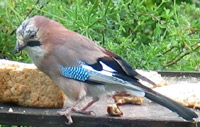
Picture, right:
This jay landed on our bird table one morning before the gulls arrived
Be a wild bird feeder:
Using bought bird foods
There are lots of commercial seeds which you can buy which are suitable for a wide variety of wild birds.
Niger seeds are very popular with some of the finches.
Sunflower seeds are very popular with a lot of birds.
Peanuts are a basic wild bird food which many species enjoy.
Peanuts are a great favourite with tits and sparrows. They must be put into a suitable birdfeeder because birds may choke on whole peanuts. You should always buy special bird food peanuts as they will have been tested for aflatoxin which can be a problem in some peanuts. So buy from a reputable supplier. It is now possible to find organic peanuts for bird food.
Why use organic foods?
Organic bird food does tend to be more expensive. However there are real health and environmental reasons for using organic feeds if you can. Organic farming tends to be far better at supporting wildlife and encouraging biodiversity than conventional farming. For more on this please see: Natural and Organic Foods for a Green Kitchen
For many people, the extra expense and difficulty of finding organic bird food is a barrier. The RSPB in the UK now has a scheme to promote bird foods with good environmental standards.
Ground feeding
If you haven’t got a bird table, you can scatter food on the ground.
It can attract rats and other vermin if you do this, so it's best to put food out on the ground early in the day so that it gets eaten before nightfall, when rats become bolder. If you scatter food regularly at the same time each day you will probably find that many of your local birds will start to wait in the surrounding bushes and trees in anticipation. My uncle used to do this and his suburban lawn was thronged with dozens of different birds every morning.
If you don't want to risk your lawn becoming fouled with pigeon droppings you can buy purpose-made ground bird feeders.
Make yourself a simple bird table
A good bird table makes a great wild bird feeder.
You can make a simple bird table very easily – even a flat square of wood nailed to a post driven into the ground will suffice to begin with. Add an edge of thin wood to stop food scattering onto the floor as birds eat. If you do this it's a good idea to leave a couple of millimetres gap between each piece of wood so that rain water can drain freely and so that you can wash the surface from time to time.
The next level is to add a roof. I’m not sure how much most birds care about that if they are hungry, but it does keep the food dry.
Be a wild bird feeder:
Positioning your bird table
If you buy or make a bird table think carefully about position. Birds like to be secure from predators, so don’t make it easy for them to be caught. Position the bird table close to a large bush or small tree so that they can hang out in the branches until they feel safe before swooping down to collect some food.
You should also place it in a relatively sheltered position. Many bird tables are rather top heavy, with elaborate roofs making them easily blown over in a boisterous wind. You might need to think about anchoring your bird table in some way.
Squirrels and other mammals can be attracted to the bird table, so you may have to put up netting to keep them off. They can be immensely persistent and rob all the decent food leaving none for the birds.
Feed consistently
If you start feeding the birds, do try to be reasonably consistent, especially in winter and early spring when food sources are often scarce. Many wild birds can become dependent upon supplementary feeding so it is not fair to suddenly stop feeding them for several weeks at a time because you've gone off for some winter sun!
The RSPB (see Green Links) now recommends feeding wild birds right around the year because so many are under threat from habitat loss and other causes.
Become a wild bird feeder:
Plant fruiting shrubs and trees for food and shelter
Many garden trees and shrubs and some annuals can be invaluable for birds, providing roosts, safe perches and food. Consider some of the following species for your garden. It is not a complete list but it includes some of the commoner berry-bearing garden trees and shrubs that attract backyard birds - natural wild bird feeders which you don't need to replenish!
Good shrubs and trees for birds
Apple trees If you have room for a big apple tree, the bluetits love them in spring and they are often full of other birds. Blackbirds and hedgehogs enjoy the fallen fruit. Windfalls and half-rotten fruits are never really wasted. I've counted more than 17 blackbirds at one time cleaning up windfall apples in my garden - not quite enough for a pie! ;)
Cotoneaster has pretty red berries which attract birds. There are many varieties to choose from. The bees love the flowers, too.
Crab apples (Malus) are also good for blackbirds.
Hawthorn berries provide food in the dead of winter and although a hawthorn hedge is a bit of a pain to trim, it provides excellent nesting sites for small birds such as the hedgesparrow (dunnock).
Holly provides masses of the familiar red berries. The wood is also highly prized by wood carvers, so if it gets too big, you can always give some of the prunings away!
Mahonia (Oregon Grape) Blackbirds love the berries and the plant is striking with its yellow flower spikes in the dead of winter. (See the picture near the top of the page of mahonia berries.)
Pyracanthus has abundant yellow to red berries and looks very fine climbing a wall. It does need the support of a structure and can become quite large.
Sunflowers provide the various tits and finches with a feast – and of course they look great too.

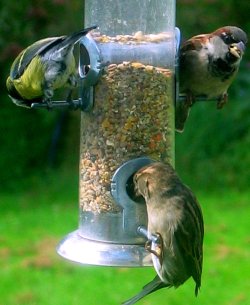
Which is the best type of wild bird feeder?
Picture: Three birds enjoying the bird feeder, a tit and two sparrows. Sparrows are becoming increasingly rare in Britain.
This large subject deserves a page to itself.
Briefly, hanging bird feeders are generally the best because they are less accessible to other wildlife. Buy something secure and easy to clean. If squirrels or rats are a problem buy the special kinds which protect the bird food, making it hard for vermin.
If you want to use peanuts get a proper peanut feeder because whole nuts are a hazard to birds.
Bird feeders with suction cups that go on the outside of your window are great fun. You need to create the right conditions for birds to come.
Become a Wild Bird Feeder! - TOP
Organic Gardening is Green Gardening
Greenfootsteps Home - for more easy green living ideas
| Tweet |

| Tweet |

On other pages
About Making Your Own Homemade Bird Foods
How to Grow Sunflowers to Feed the Birds
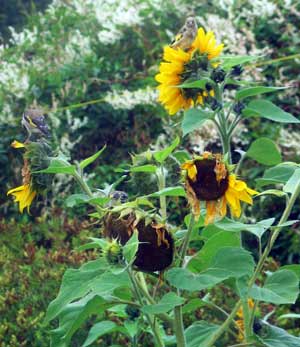
(Not my best shot - but if you look closely at the picture you will see goldfinches feeding on the sunflowers!)
Advertisements
Footprints
- an occasional e-zine from Greenfootsteps
If you would like to receive the e-zine, please just sign up below.







New! Comments
Have your say about what you just read! Leave me a comment in the box below.